Trevor Strohman
Efficient Adapter Finetuning for Tail Languages in Streaming Multilingual ASR
Jan 17, 2024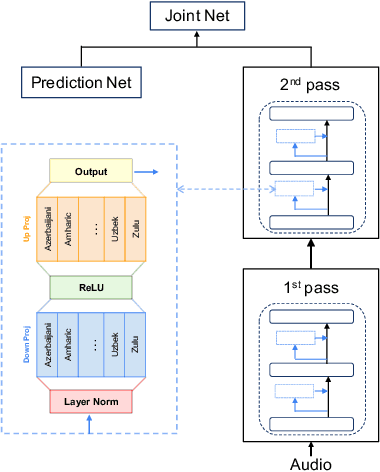


Abstract:The end-to-end ASR model is often desired in the streaming multilingual scenario since it is easier to deploy and can benefit from pre-trained speech models such as powerful foundation models. Meanwhile, the heterogeneous nature and imbalanced data abundance of different languages may cause performance degradation, leading to asynchronous peak performance for different languages during training, especially on tail ones. Sometimes even the data itself may become unavailable as a result of the enhanced privacy protection. Existing work tend to significantly increase the model size or learn language-specific decoders to accommodate each language separately. In this study, we explore simple yet effective Language-Dependent Adapter (LDA) finetuning under a cascaded Conformer transducer framework enhanced by teacher pseudo-labeling for tail languages in the streaming multilingual ASR. The adapter only accounts for 0.4% of the full model per language. It is plugged into the frozen foundation model and is the only trainable module during the finetuning process with noisy student training. The final model merges the adapter parameters from different checkpoints for different languages. The model performance is validated on a challenging multilingual dictation dataset, which includes 39 tail languages across Latin, Greek, Arabic, etc. Our proposed method brings 12.2% word error rate reduction on average and up to 37.5% on a single locale. Furthermore, we show that our parameter-efficient LDA can match the quality of the full model finetuning, thus greatly alleviating the asynchronous peak performance issue.
Gemini: A Family of Highly Capable Multimodal Models
Dec 19, 2023Abstract:This report introduces a new family of multimodal models, Gemini, that exhibit remarkable capabilities across image, audio, video, and text understanding. The Gemini family consists of Ultra, Pro, and Nano sizes, suitable for applications ranging from complex reasoning tasks to on-device memory-constrained use-cases. Evaluation on a broad range of benchmarks shows that our most-capable Gemini Ultra model advances the state of the art in 30 of 32 of these benchmarks - notably being the first model to achieve human-expert performance on the well-studied exam benchmark MMLU, and improving the state of the art in every one of the 20 multimodal benchmarks we examined. We believe that the new capabilities of Gemini models in cross-modal reasoning and language understanding will enable a wide variety of use cases and we discuss our approach toward deploying them responsibly to users.
Controlled Decoding from Language Models
Oct 25, 2023



Abstract:We propose controlled decoding (CD), a novel off-policy reinforcement learning method to control the autoregressive generation from language models towards high reward outcomes. CD solves an off-policy reinforcement learning problem through a value function for the reward, which we call a prefix scorer. The prefix scorer is used at inference time to steer the generation towards higher reward outcomes. We show that the prefix scorer may be trained on (possibly) off-policy data to predict the expected reward when decoding is continued from a partially decoded response. We empirically demonstrate that CD is effective as a control mechanism on Reddit conversations corpus. We also show that the modularity of the design of CD makes it possible to control for multiple rewards, effectively solving a multi-objective reinforcement learning problem with no additional complexity. Finally, we show that CD can be applied in a novel blockwise fashion at inference-time, again without the need for any training-time changes, essentially bridging the gap between the popular best-of-$K$ strategy and token-level reinforcement learning. This makes CD a promising approach for alignment of language models.
Practical Conformer: Optimizing size, speed and flops of Conformer for on-Device and cloud ASR
Mar 31, 2023

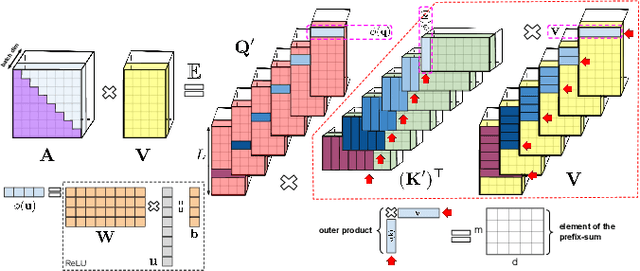

Abstract:Conformer models maintain a large number of internal states, the vast majority of which are associated with self-attention layers. With limited memory bandwidth, reading these from memory at each inference step can slow down inference. In this paper, we design an optimized conformer that is small enough to meet on-device restrictions and has fast inference on TPUs. We explore various ideas to improve the execution speed, including replacing lower conformer blocks with convolution-only blocks, strategically downsizing the architecture, and utilizing an RNNAttention-Performer. Our optimized conformer can be readily incorporated into a cascaded-encoder setting, allowing a second-pass decoder to operate on its output and improve the accuracy whenever more resources are available. Altogether, we find that these optimizations can reduce latency by a factor of 6.8x, and come at a reasonable trade-off in quality. With the cascaded second-pass, we show that the recognition accuracy is completely recoverable. Thus, our proposed encoder can double as a strong standalone encoder in on device, and as the first part of a high-performance ASR pipeline.
Google USM: Scaling Automatic Speech Recognition Beyond 100 Languages
Mar 03, 2023
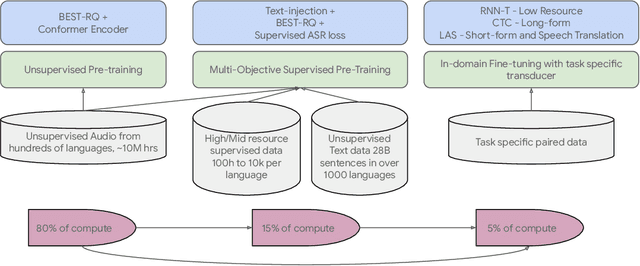


Abstract:We introduce the Universal Speech Model (USM), a single large model that performs automatic speech recognition (ASR) across 100+ languages. This is achieved by pre-training the encoder of the model on a large unlabeled multilingual dataset of 12 million (M) hours spanning over 300 languages, and fine-tuning on a smaller labeled dataset. We use multilingual pre-training with random-projection quantization and speech-text modality matching to achieve state-of-the-art performance on downstream multilingual ASR and speech-to-text translation tasks. We also demonstrate that despite using a labeled training set 1/7-th the size of that used for the Whisper model, our model exhibits comparable or better performance on both in-domain and out-of-domain speech recognition tasks across many languages.
UML: A Universal Monolingual Output Layer for Multilingual ASR
Feb 22, 2023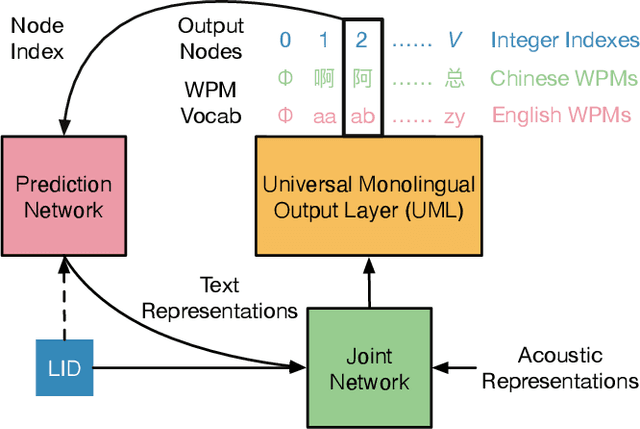
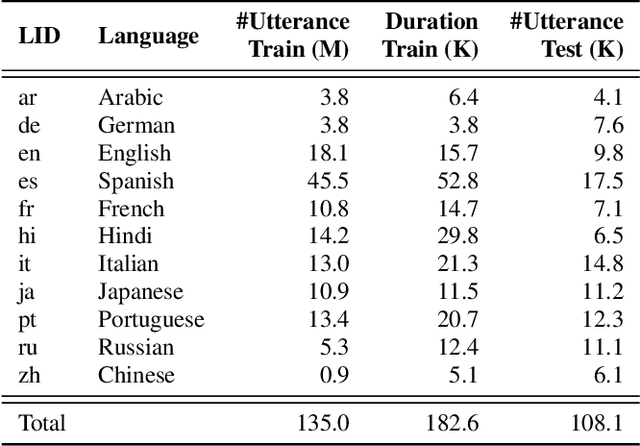
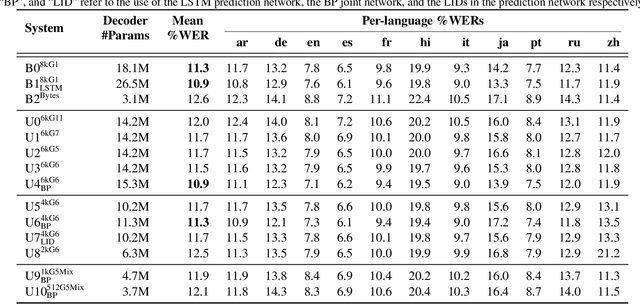
Abstract:Word-piece models (WPMs) are commonly used subword units in state-of-the-art end-to-end automatic speech recognition (ASR) systems. For multilingual ASR, due to the differences in written scripts across languages, multilingual WPMs bring the challenges of having overly large output layers and scaling to more languages. In this work, we propose a universal monolingual output layer (UML) to address such problems. Instead of one output node for only one WPM, UML re-associates each output node with multiple WPMs, one for each language, and results in a smaller monolingual output layer shared across languages. Consequently, the UML enables to switch in the interpretation of each output node depending on the language of the input speech. Experimental results on an 11-language voice search task demonstrated the feasibility of using UML for high-quality and high-efficiency multilingual streaming ASR.
Massively Multilingual Shallow Fusion with Large Language Models
Feb 17, 2023Abstract:While large language models (LLM) have made impressive progress in natural language processing, it remains unclear how to utilize them in improving automatic speech recognition (ASR). In this work, we propose to train a single multilingual language model (LM) for shallow fusion in multiple languages. We push the limits of the multilingual LM to cover up to 84 languages by scaling up using a mixture-of-experts LLM, i.e., generalist language model (GLaM). When the number of experts increases, GLaM dynamically selects only two at each decoding step to keep the inference computation roughly constant. We then apply GLaM to a multilingual shallow fusion task based on a state-of-the-art end-to-end model. Compared to a dense LM of similar computation during inference, GLaM reduces the WER of an English long-tail test set by 4.4% relative. In a multilingual shallow fusion task, GLaM improves 41 out of 50 languages with an average relative WER reduction of 3.85%, and a maximum reduction of 10%. Compared to the baseline model, GLaM achieves an average WER reduction of 5.53% over 43 languages.
Efficient Domain Adaptation for Speech Foundation Models
Feb 03, 2023Abstract:Foundation models (FMs), that are trained on broad data at scale and are adaptable to a wide range of downstream tasks, have brought large interest in the research community. Benefiting from the diverse data sources such as different modalities, languages and application domains, foundation models have demonstrated strong generalization and knowledge transfer capabilities. In this paper, we present a pioneering study towards building an efficient solution for FM-based speech recognition systems. We adopt the recently developed self-supervised BEST-RQ for pretraining, and propose the joint finetuning with both source and unsupervised target domain data using JUST Hydra. The FM encoder adapter and decoder are then finetuned to the target domain with a small amount of supervised in-domain data. On a large-scale YouTube and Voice Search task, our method is shown to be both data and model parameter efficient. It achieves the same quality with only 21.6M supervised in-domain data and 130.8M finetuned parameters, compared to the 731.1M model trained from scratch on additional 300M supervised in-domain data.
From English to More Languages: Parameter-Efficient Model Reprogramming for Cross-Lingual Speech Recognition
Jan 19, 2023



Abstract:In this work, we propose a new parameter-efficient learning framework based on neural model reprogramming for cross-lingual speech recognition, which can \textbf{re-purpose} well-trained English automatic speech recognition (ASR) models to recognize the other languages. We design different auxiliary neural architectures focusing on learnable pre-trained feature enhancement that, for the first time, empowers model reprogramming on ASR. Specifically, we investigate how to select trainable components (i.e., encoder) of a conformer-based RNN-Transducer, as a frozen pre-trained backbone. Experiments on a seven-language multilingual LibriSpeech speech (MLS) task show that model reprogramming only requires 4.2% (11M out of 270M) to 6.8% (45M out of 660M) of its original trainable parameters from a full ASR model to perform competitive results in a range of 11.9% to 8.1% WER averaged across different languages. In addition, we discover different setups to make large-scale pre-trained ASR succeed in both monolingual and multilingual speech recognition. Our methods outperform existing ASR tuning architectures and their extension with self-supervised losses (e.g., w2v-bert) in terms of lower WER and better training efficiency.
Resource-Efficient Transfer Learning From Speech Foundation Model Using Hierarchical Feature Fusion
Nov 04, 2022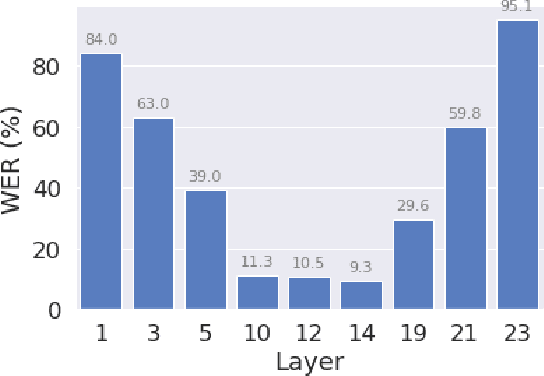
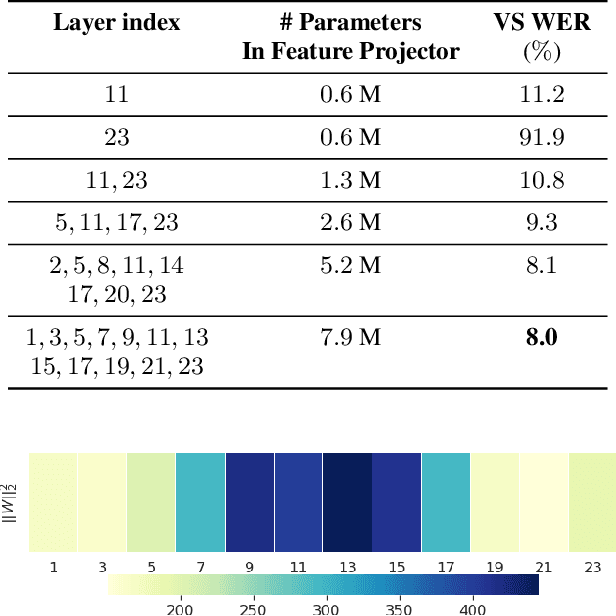
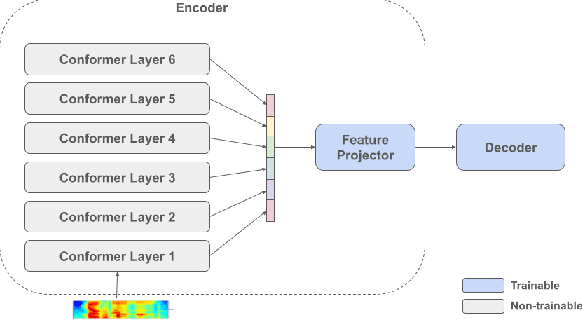
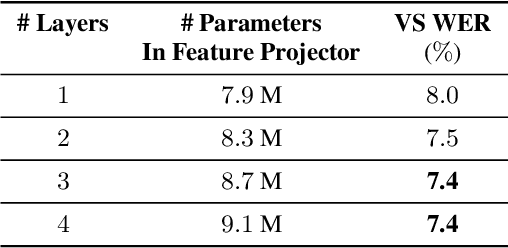
Abstract:Self-supervised pre-training of a speech foundation model, followed by supervised fine-tuning, has shown impressive quality improvements on automatic speech recognition (ASR) tasks. Fine-tuning separate foundation models for many downstream tasks are expensive since the foundation model is usually very big. Parameter-efficient fine-tuning methods (e.g. adapter, sparse update methods) offer an alternative paradigm where a small set of parameters are updated to adapt the foundation model to new tasks. However, these methods still suffer from a high computational memory cost and slow training speed because they require backpropagation through the entire neural network at each step. In the paper, we analyze the performance of features at different layers of a foundation model on the speech recognition task and propose a novel hierarchical feature fusion method for resource-efficient transfer learning from speech foundation models. Experimental results show that the proposed method can achieve better performance on speech recognition task than existing algorithms with fewer number of trainable parameters, less computational memory cost and faster training speed. After combining with Adapters at all layers, the proposed method can achieve the same performance as fine-tuning the whole model with $97\%$ fewer trainable encoder parameters and $53\%$ faster training speed.
 Add to Chrome
Add to Chrome Add to Firefox
Add to Firefox Add to Edge
Add to Edge